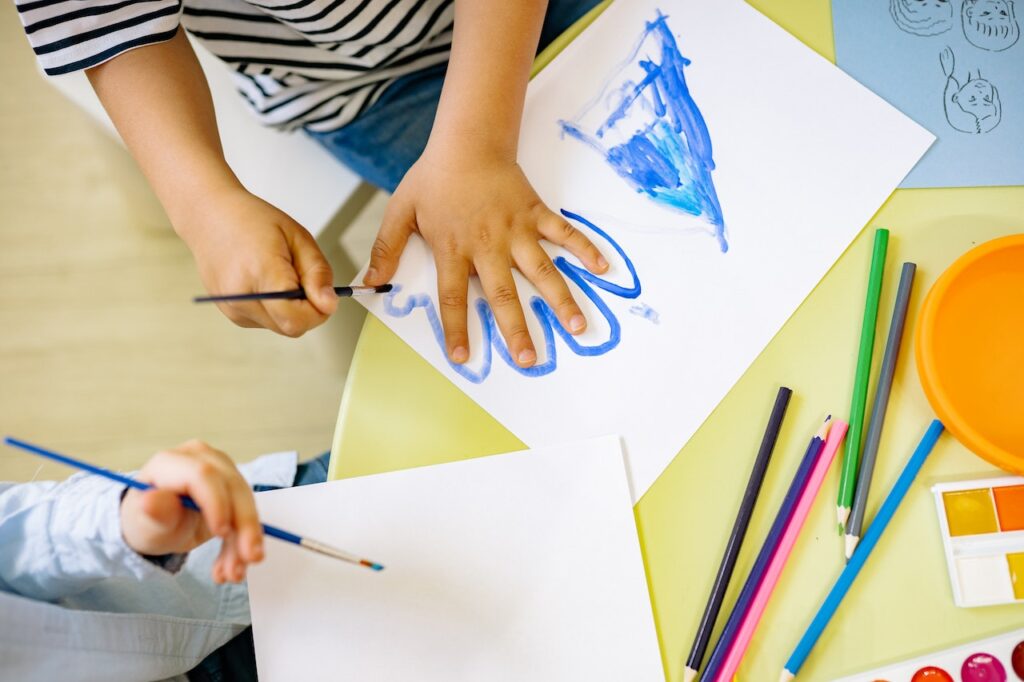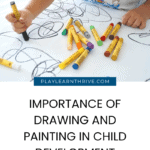Unraveling the Importance of Drawing and Painting in Child Development
Have you ever watched your child pick up a crayon and start doodling? Their little faces light up with concentration, their small hands move with purpose, and suddenly, the page is alive with color and form. For a moment, pause and think: Why do children naturally gravitate towards drawing and painting?
Play. Learn. Thrive.™ only endorses products we authentically love and use. Some of the product links in this post may be affiliate links. That means that if you click them and make a purchase, this site makes a commission. Play. Learn. Thrive.™ is also an Amazon Associate. As an Amazon Associate, we earn from qualifying purchases. It will have no impact on the price you pay or the experience of your purchase.
Leonardo da Vinci once said, “Painting is poetry that is seen rather than felt.” Could it be that every child is a budding poet, waiting to share their view of the world? Let's take a deeper look at the importance of drawing and painting in child development.

The Importance of Drawing and Painting in Child Development
1. Expressing Themselves
Kids often find it challenging to express their thoughts and feelings verbally. Drawing and painting provide an alternative way for them to communicate. Whether they're happy, sad, excited, or confused, art gives them a safe space to express their emotions.
So, when your little one hands you a drawing of a smiling sun or a gloomy rain cloud, take a moment to understand the message behind it and ask them about it. Remember, art is sometimes more about the process and not so much the product.
2. Boosting Creativity
Creativity isn't just for artists or designers; it's a skill that can benefit children in all areas of life. When kids engage in drawing and painting, they're encouraged to think outside the box. They experiment with colors, shapes, and lines, which helps develop their problem-solving skills and imagination. This creativity can be a game-changer as they grow and encounter new challenges.
3. Developing Fine Motor Skills
Fine motor skills are essential for everyday tasks like buttoning shirts, tying shoelaces, and using utensils. Drawing and painting require kids to use their hands and fingers with precision. Holding a crayon, making controlled strokes with a paintbrush, or cutting paper with scissors all help fine-tune these skills. It's like a workout for their little fingers!
4. Building Confidence
Every scribble, doodle, or colorful masterpiece is a source of pride for your child. Encouraging them to create and praising their efforts boosts their self-esteem. We keep a section of wall in our playroom designated for displaying artwork our little ones are particularly proud of.
When kids see that their artwork is appreciated, it builds their confidence and encourages them to take on new challenges with enthusiasm. And the moment you see this in their faces, you'll understand the importance of drawing and painting in child development.
5. Patience and Focus
In today's fast-paced world, patience can be a rare trait. Drawing and painting teach kids the value of patience and focus. Completing an art project often requires sustained attention to detail and the ability to stick with it until it's done. These skills will serve them well in school and in life.
Drawing and painting have always been able to keep our girls' attention and focus for extended periods of time.
6. Stress Relief
Even children experience stress and anxiety from time to time. Art can be a fantastic stress reliever. When kids dive into their creative zone, they momentarily forget about their worries. It's like a mini-therapy session without the talking. So, when your child has a tough day, suggest some art time as a way to unwind.
According to the Institute of Education Sciences, drawing and painting are essential tools for nurturing well-rounded, emotionally resilient, and creative individuals ready to face the challenges of tomorrow.
As the famous artist Georgia O'Keeffe aptly put it, “I found I could say things with color and shapes that I couldn't say any other way – things I had no words for.” In this age, we need more such voices, and art is the key.
7. Learning about the World
Art is not just about random scribbles; it's a way for kids to explore and understand the world around them. When they draw a tree, they observe its shape and color. When they paint a rainbow, they learn about the order of colors. Art helps them make sense of the world one drawing at a time.
Drawing and painting are more than just fun activities; they're essential tools for your child's growth and development. Encourage their artistic endeavors, display their artwork proudly, and watch as they blossom into confident, creative, and expressive individuals. So, next time you see your child with a crayon in hand, know that they're not just making art; they're crafting a brighter future for themselves.
Supporting Young Artists: Fostering Creativity through Drawing and Painting
Art, at its core, is a deeply personal endeavor. Yet, the environment in which it's nurtured can significantly influence its trajectory. As guardians, parents, and mentors, our role isn't just to appreciate the colorful creations our children present us with but to actively support and foster their artistic journeys. How can we do this in meaningful ways?
Creating a Nurturing Environment
Artistic Spaces:
Designate a space in your home for artistic exploration. Whether it's a corner of a room or an entire table, having a dedicated space signals to the child the importance of their creative endeavors.
Accessible Materials:
Ensure that art supplies like crayons, watercolors, and paper are easily accessible. You'd be surprised how a spontaneous moment of inspiration can lead to a masterpiece when tools are at hand.
Embrace the Mess:
Yes, paint might end up on the walls, and glitter could find its way into every nook and cranny. But remember, creativity is often messy! Embrace it as part of the process.
Engaging with Their Art
Active Participation:
The importance of drawing and painting in child development goes beyond the simple act of doodling and coloring. It gives us as the parents/caregivers to actively engage with our little ones. Join your child in their art sessions. Draw, paint, or simply doodle alongside them. It not only gives them encouragement but also becomes a bonding activity.
Open-ended Questions:
When presented with their latest creation, instead of a simple “That's nice!”, delve deeper. Ask, “Can you tell me about what you've drawn?” or “Why did you choose these colors?” It makes them think and articulate their creative choices.
Respecting Their Perspective:
There might be times you don’t understand their art. That's okay. The important thing is to respect their vision and expression. Remember, Picasso's works were once misunderstood too!
Exposing Them to the World of Art
Museum Visits:
Take them to art museums or galleries. Let them witness the vast spectrum of human artistic expression. Who knows? They might get inspired by Van Gogh's strokes or Frida Kahlo's vibrant colors.
Art Books and Shows:
Introduce them to art-themed books or shows. Stories about artists, illustrative children’s books, or even documentaries can ignite their imagination.
Local Art Workshops:
Many communities host workshops or art camps for children. It's a fantastic opportunity for them to learn new techniques and mingle with fellow young artists.
Encouraging Continuous Learning
Artistic Challenges:
Encourage them to try drawing challenges, like creating something using only three colors or drawing without lifting the pencil. It pushes their boundaries and stimulates creativity.
Feedback, Not Criticism:
Constructive feedback can be invaluable. Instead of pointing out ‘mistakes', phrase it positively. Say, “I love how you drew the sun; what if you added some birds flying nearby?”
The Importance of Drawing and Painting in Child Development
In the end, the most significant role you can play in your child's artistic journey is being their unwavering supporter. Celebrate their successes, console them through frustrations, and most importantly, remind them that their unique perspective is a gift to the world. As we champion the artists of tomorrow, we're not just fostering their talent but also cultivating a richer, more colorful world for us all.

